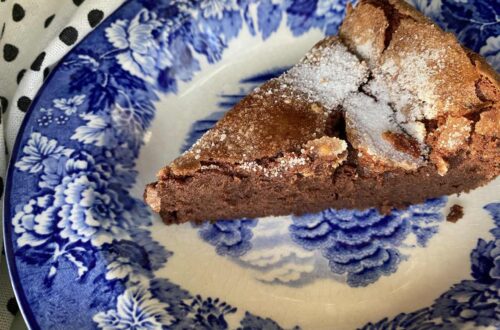
Chocolate Chocolate-Chip Cherry Cookies
Every once in a while, you stumble upon a special cookie recipe. It’s the kind that, once you’ve tasted it, you suddenly know: these cookies will forever be part of your core toolbox of cookies, just waiting to be baked at a moment’s notice. These cookies – chocolaty, gooey, mixed with a tartness from the cherries – have served me well since I discovered them. They satisfy a deep chocolate craving, whether that’s at a picnic, a dinner with friends or as a delightful snack during the low point of the work-from-home afternoon or after a long summer evening walk.
I have also been searching for the right recipe to once again dive into the cocoa supply chain. Yasmin Khan’s recipe for this recipe is perfect, since she was a human rights campaigner before becoming a cookbook author. While issues around trafficked and forced child labor in the West African cocoa industry generally make the headlines, deforestation is another important, if not as widely known, issue in the cocoa sector.
Ghana and Cote d’Ivoire, which together produce over 60 percent of the world’s cocoa, have lost massive areas of forest to cocoa farms over the past fifty years. This large-scale deforestation is in part a result of the poverty wages that chocolate companies like Nestlé and Hershey pay for cocoa and their willingness to look the other way while buying cocoa produced in protected forests. The average cocoa farmer in Ghana and Cote d’Ivoire works on a small family-owned farm, often between 3-5 hectares, and earns about half of what the World Bank’ sets as the global poverty line. Companies pay such low prices for cocoa that farmers can barely survive. National forests have land ripe for the picking – and planting. Producing more cocoa, even at the expense of a protected forest, is a means for farmers to feed their families and send their children to school.
This deforestation has had devastating consequences. Cote d’Ivoire was a heavily forested country in the 1960s and had a range of wildlife, including elephants, pygmy hippos, flying squirrels, pangolins, leopards and crocodiles. Today, thirteen of twenty-three protected areas have no more primates. Moreover, of these twenty-three protected areas, seven are almost fully cocoa farms. Yet these farmers’ encroachment into protected areas is not really a choice. As the VOICE Network, a non-profit organization that works to create a sustainable cocoa industry, explains: “When farmers must choose between feeding their family, and not cutting down old growth trees, it is not a choice.”
But companies that buy this cocoa do have a choice. Cocoa farmers in protected forests are able to expand because multinational companies look the other way. Companies have promised to stop deforestation – a promise they have failed to live up to, with more trees being cut down each day. Moreover, every company has “direct” and “indirect” (meaning cocoa bought informally with little oversight) supply chains. While the last two years have seen an increase in companies’ public information on the direct supply chains, cocoa from protected forests comes from the indirect supply chains. Despite corporate promises, it’s been estimated that 40 percent of Cote d’Ivoire’s cocoa is grown in protected areas. That means that 40 percent of the cocoa in a bag of chocolate chips is produced with cocoa grown in a protected forest.
To learn more about deforestation from the cocoa industry, take a look at this Washington Post article (they have some of the best reporting on the cocoa industry). And here’s what you can do. Don’t buy chocolate from Nestlé, Mars, Hershey, Ferrero, and the other multinational companies. Instead, look for companies that tell you where they bought their cocoa – down to the exact farms. If a company knows who is producing their cocoa, they are more likely to have a relationship with the farmer or farmer group, more likely to know where the farm is located, and less likely to exploit the farmer. As a starting point, check out these nineteen cocoa and chocolate companies that signed amicus briefs (eighteen companies on one brief and one on a second brief) in favor of regulating cocoa imports.
Chocolate Chocolate-Chip and Cherry Cookies
Course: Dessert, Recipe14
servings2
hoursIngredients
1¼ cups all-purpose flour
¼ cup cocoa powder
½ teaspoon baking soda
½ teaspoon baking powder
¼ teaspoon sea salt
1¼ sticks (10 tablespoons) butter
½ cup dark brown sugar
¼ cup plus 2 tablespoons granulated sugar
1 large egg
1 teaspoon vanilla extract
½ cup dark chocolate chips
¾ cups dried cherries (sour cherries are great), roughly chopped
Flaky sea salt for sprinkling
Directions
- Combine the flour, cocoa, baking soda, and baking powder, and salt in a medium bowl.
- In a separate large bowl, cream the butter with the brown sugar and granulated sugar until it is creamy. (You can use a stand mixer or a hand mixer to do this.) Add the egg and vanilla extract and mix to combine.
- Add the dry mixture to the creamed butter slowly, being careful not to let the cocoa and flour fly up and out of the bowl.
- When the dry mixture has been combined, add the chocolate chips and dried cherries and mix until the cherries and the chips are spread equally in the dough.
- Pour the dough out onto parchment paper and shape it into a log, about two inches thick. (The size and length doesn’t matter much – it just makes it easier to cut the cookies later.) Put the dough in the fridge and let sit for at least one hour and up to two days.
- After at least an hour, take the dough out of the fridge. Cut the log into fourteen slices. Roll each slice into a ball and place on a baking sheet lined with parchment paper.
- Preheat the oven to 325˚ F. Bake the cookies for 11-12 minutes. They should be soft in the middle – it’s okay if they are still a little gooey. Sprinkle the flaky sea salt over the cookies immediately and let them cool for about 5 minutes on the baking tray. Then move them to a drying rack to cool completely.




